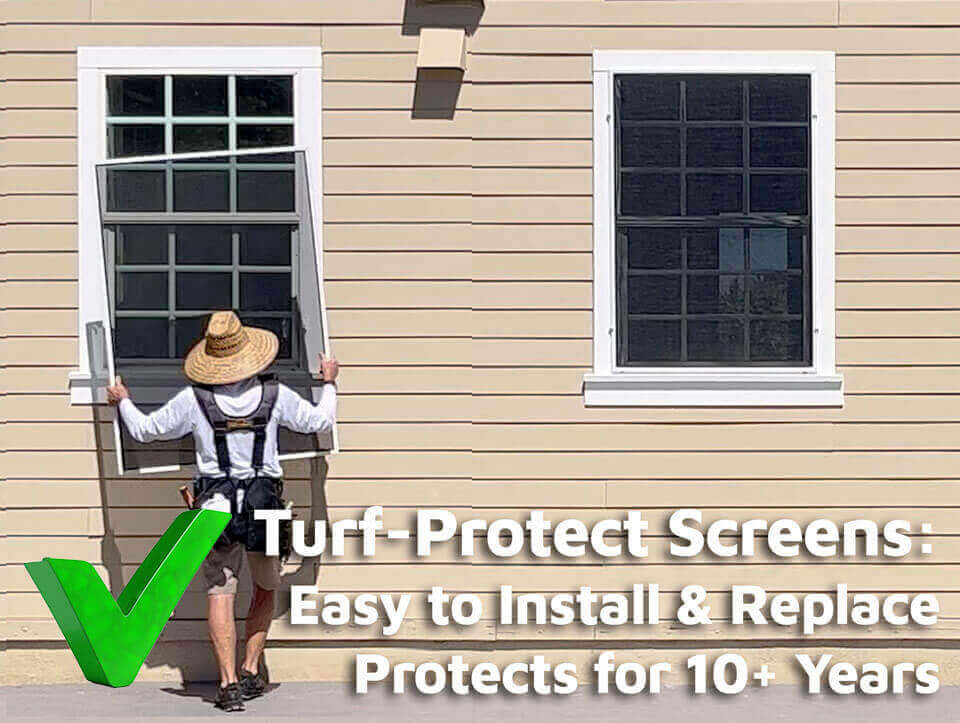Low-E windows are installed in most new homes, and many people are discovering a frustrating side-effect of their Low-E windows: concentrated sun reflection is causing their artificial turf to burn and melt.
There are a few ways to tame intense window reflections: install anti reflective window film, or get special-purpose window screens.
In this article, we’ll explore how anti reflective window film works, what are the typical costs for window-film installation, and a few other important considerations.
Alternatively, skip reading all of that, and get Turf Protect window screens from Total Screen.
Turf Protect window screens are generally cheaper to install than window film, plus Turf Protect guarantees 100% reflection-prevention, and they feature a 2-second quick-removal process, for easy window cleaning.

See more about Turf Protect window screens here, or continue reading about anti-reflection window films below.
Understanding Low-E Windows
Low-E (low-emissivity) windows come with high-tech coatings that reflect heat away from a home, making your home interior cooler, and more energy-efficient.
The downside is that these same energy-efficient window coatings can also reflect sunlight powerfully onto nearby surfaces—much like a magnifying glass pointed at artificial grass.
Temperatures on these “hot spots” can climb far above ambient levels, leaving unsightly damage to lawns, fences, or even car trim.
How Anti Reflective Window Film Helps
Diffusing Intense Reflections
Anti reflective window film is specifically designed to break up the concentrated glare that Low-E coatings cause.
By using a micro-pattern or screen-like layer on the outside of the glass, this film scatters the reflected sunlight into multiple directions.
Rather than a powerful beam aimed straight at your artificial turf, the light disperses over a broader area, dramatically reducing dangerous heat buildup.
After installation, homeowners typically see fewer scorch marks and brown patches, because the film stops the “lens effect” at its source.
Maintaining Visibility and Light
Contrary to what some might think, today’s anti reflective window film doesn’t necessarily darken your view from the inside.
Many products resemble a thin mesh or perforated sheet that remains nearly transparent when you look out.
While there can be a slight difference in clarity, well-made films allow you to enjoy natural light without the mirror-like shine outside.
In short, you still reap the benefits of your Low-E window—helping keep indoor temperatures comfortable—while preventing meltdown in your yard.
Exterior Installation is Key
Applying the film on the exterior of the glass is crucial. Doing so stops the sunlight before it bounces off the Low-E coating.
Interior-applied tinting or films, on the other hand, often do not address exterior reflections and may just trap heat between the glass panes.
Most anti reflective window film is weatherproof and UV-resistant, allowing it to hold up well in sunny, warm regions.
Cost Considerations
Installing anti reflective window film is generally more affordable than continuously replacing melted turf or warped vinyl siding.
However, it can still be a noticeable expense, depending on how many windows you need to treat.
Some homeowners opt for do-it-yourself application kits, which might cost around five to eight dollars per square foot in materials.
Professional installation can be higher—often ranging from around ten to twenty dollars per square foot—because it includes both labor and the film itself.
The choice comes down to your budget, comfort with DIY work, and whether you have windows that are easy to reach from the ground.
Advantages Beyond Turf Protection
While the main goal is to tame the destructive glare outside, many modern anti reflective window films also block a high percentage of UV rays.
In turn, you could notice less fading on interior furniture, floors, and curtains over time. Some types of mesh films even provide a moderate level of daytime privacy, making them popular in neighborhoods where windows face busy streets or close-by neighbors.
These benefits help justify the investment for those who want a simple, one-and-done approach to the turf-meltdown problem.
Why Turf Protect Window Screens May Be a Better Choice
Despite the effectiveness of anti reflective window film, there’s an alternative that is generally cheaper, faster to install, and equally if not more effective at controlling powerful window reflections: Turf Protect window screens.
They serve as a durable barrier against those intense rays, offering near-instant results.
Turf Protect window screens are custom-fitted, easy to maintain, and can be installed quickly.
Many homeowners find that screens resolve the turf-melting problem without the higher costs or specialized adhesives required for most film products.
Plus, the thicker mesh diffuses the sun’s heat while preserving your view, so you enjoy the outdoors without worrying about scorching marks on your lawn, fence, or siding.
To learn more about how Turf Protect window screens can help you avoid the frustration of melted artificial grass, check out our “Window Reflections Can Burn Turf” article here:
( https://totalscreen.com/turf-melt-prevention/window-reflections-can-burn-turf/ )
If your lawn is already damaged, don’t lose hope—see how to tackle repairs or replacements by reading our “How to Fix Melted Turf” post at:
( https://totalscreen.com/turf-melt-prevention/how-to-fix-melted-turf/ )
Ultimately, while anti reflective window film is a proven way to manage dangerous reflections from Low-E windows, Turf Protect window screens are often more convenient and cost-effective.
Whichever route you choose, you can look forward to stopping unsightly turf melt, safeguarding your outside spaces, and reclaiming a healthy, attractive yard—no more hiding from the sun’s harsh glare.
